第四章 缓冲包装设计五步法
- 格式:ppt
- 大小:6.79 MB
- 文档页数:63
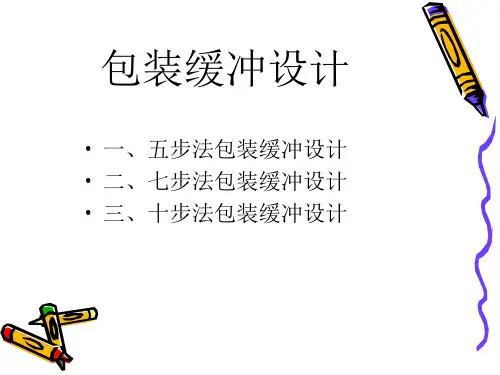
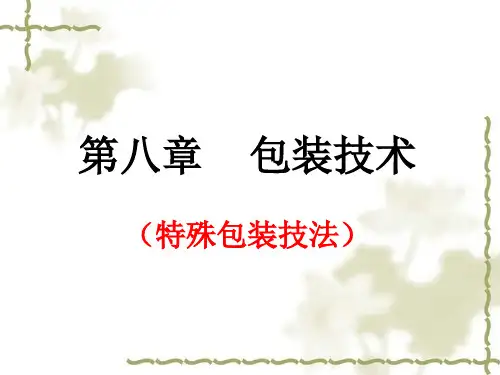
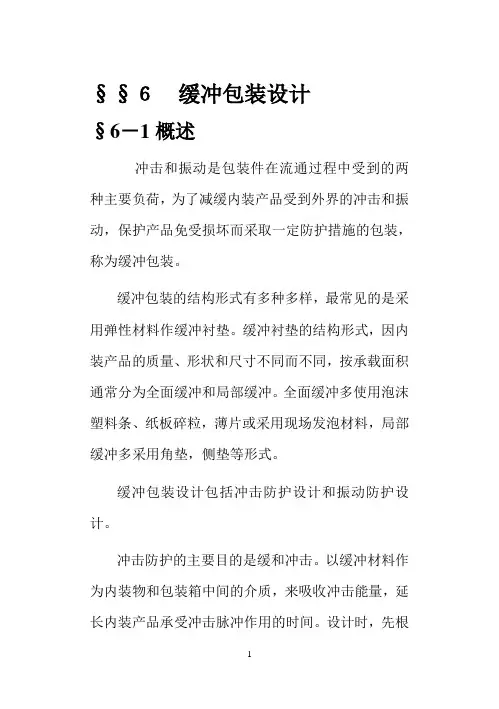
§§6缓冲包装设计§6-1概述冲击和振动是包装件在流通过程中受到的两种主要负荷,为了减缓内装产品受到外界的冲击和振动,保护产品免受损坏而采取一定防护措施的包装,称为缓冲包装。
缓冲包装的结构形式有多种多样,最常见的是采用弹性材料作缓冲衬垫。
缓冲衬垫的结构形式,因内装产品的质量、形状和尺寸不同而不同,按承载面积通常分为全面缓冲和局部缓冲。
全面缓冲多使用泡沫塑料条、纸板碎粒,薄片或采用现场发泡材料,局部缓冲多采用角垫,侧垫等形式。
缓冲包装设计包括冲击防护设计和振动防护设计。
冲击防护的主要目的是缓和冲击。
以缓冲材料作为内装物和包装箱中间的介质,来吸收冲击能量,延长内装产品承受冲击脉冲作用的时间。
设计时,先根据先决条件,计算缓冲材料的尺寸、形状,选择缓冲材料的种类和缓冲方式。
振动防护的主要目的是调节包装件的固有频率。
选择恰当的阻尼材料,把包装系统对振动的传递率控制在预定的范围内,特别是要避免共振现象。
§6-2缓冲衬垫设计的基本方法一、衬垫结构尺寸设计设计缓冲衬垫的基本要求是在保护产品免遭破损的前提下,选择适当的材料,确定合理的结构形状和尺寸。
设计的基本参数,除产品的重量和尺寸外,还有代表流通环境的跌落高度H,代表产品强度的脆值G,代表材料性能的缓冲特性参数C。
正确应用缓冲材料的特性曲线对包装结构作系统的定量分析,是缓冲结构设计的基本方法。
1. 应用缓冲系统――最大应力(c~σm)曲线设计衬垫尺寸c~σm曲线是表示材料缓冲能力的一种基本曲线,通过静态压缩试验求得。
如图5-12所示为几种常用缓冲衬垫最大缓冲系数――最大应力曲线的实际测试结果。
由图可知:缓冲系数C随最大应力变化的规律是凹谷状,开口向上,谷底最低点的坐标是最小缓冲系数和所对应的最应力。
① 不同品质的材料,具有不同的缓冲能力; ② 同样品种的材料,密度不同,缓冲特性也不同。
例6-1:重为10kg 的产品,脆值为80g ,要保证从60 cm 的高处跌落而不破损,若用密度为0.031g/cm 3的聚氯乙烯塑料泡沫,(见P99图5-12图线10作衬垫,试计算衬垫所需尺寸。
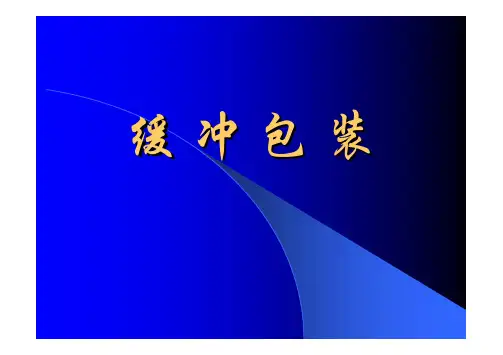

包装设计五步法
第一步:
明确企业与产品的定位及卖点。
这是着手于包装设计的第一步,定位和卖点很关键,它是包装能否具有特色的核心点,也是立足市场的着眼点
第二步:
找好目标消费群,明确核心消费群的价值观和审美情趣。
按照目标消费群的性格喜悦、审美情趣以及购买习惯等为基础来进行包装设计。
第三步:
研究同类产品,寻找突破。
参考同档次、同品种或者相同价值定位的其他包装,然后建立区隔点、寻找突破点和强化点!在包装形态,色系、人物、字体等等地方寻找突破和区隔。
第四步:
寻找包装风格和调性,并加以设计。
调性和风格是最能建立独特品牌价值主张与灵魂的东西。
整体与产品匹配,强化包装的基础要素-结构,形态,色系、人物、字体等等。
第五步:
突出和强调包装特性。
夸大和强化包装与包装产品的特性,充分发挥出产品本身的优势,着重特性的设计,这也是最能在同品类产品中突出来的展示点。
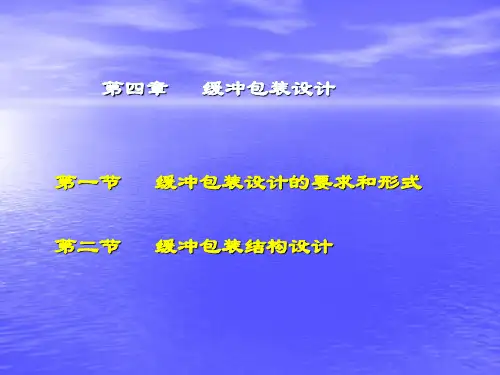
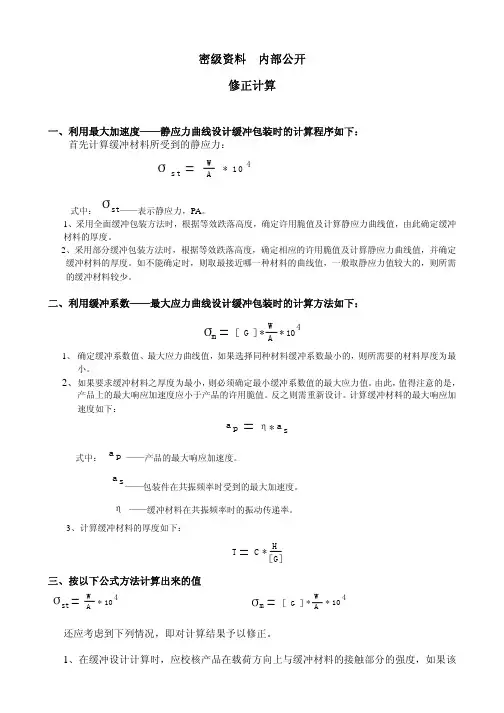
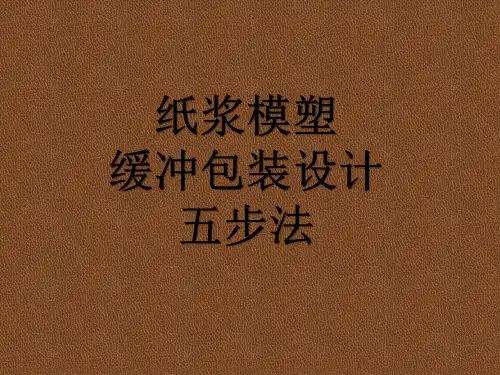
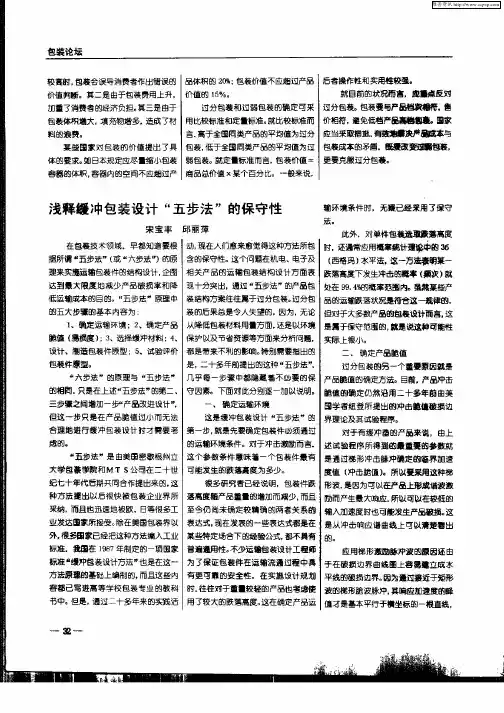

摘要随着我国经济的快速增长,生活频率的加快,电脑发挥的作用越来越重要。
由于笔记本电脑具有体积小、重量轻、携带方便等优点,其便携性和备用电源更使移动办公成为可能,因此越来越受用户推崇,市场需求量迅速增长。
但笔记本电脑属于电子类产品在运输及销售环节中可能会受到外界的冲击或震荡,对其质量和外观造成一定的破坏。
为了避免这种情况发生,应对笔记本电脑进行系统的缓冲(防震)包装设计,其包括:缓冲包装设计、防震设计、外包装尺寸设计。
做好缓冲包装设计应首先确定产品的尺寸等数据,做出产品脆值估计,然后选择合适的缓冲材料。
计算出缓冲衬垫的尺寸,最后判断设计的合理性。
防震包装设计则应考虑到包装系统(外包装——衬垫——内装产品)的固有频率,加速度值在产品许用脆值范围内。
外包装尺寸设计应先选择合适的包装材料,设计其厚度,再根据被包装的尺寸,计算出其内尺寸、制造尺寸、外尺寸。
因此选择适合的缓冲包装材料与结构、计算出准确的尺寸对于缓冲衬垫和外包装箱的设计是非常重要的。
本文是在确定设计对象的尺寸、重量和流通环境等一系列的条件的基础上,针对12.1英寸笔记本电脑进行了系统的缓冲包装设计。
关键词:笔记本电脑;缓冲包装设计;防震包装设计AbstractAs China's rapid economic growth, the acceleration of the frequency of life, the role of the computer more and more important. As the laptop has a small size, light weight and easy to carry, etc., and its portability and standby power mobile office makes it possible, so more and more respected by the users, the rapid growth of market demand. But notebook computers are electronic products and sales in the transport chain may be subject to external shocks or shocks to their quality and appearance of a certain degree of damage caused. To avoid this from happening, the notebook computer system to deal with the buffer (earthquake) packaging design,Include: the design of cushioning packaging, shock-proof design, package design size. Do a good job in the design of cushioning packaging products should first determine the size of such data, the estimated value to product crisp, and then choose a suitable buffer material. To calculate the size of the buffer pad, and finally to determine the reasonableness of the design. Shockproof taken into account should be packaging design packaging system (packaging - liner - containing products) of the natural frequency, acceleration values allowable in the product range of crisp values. Package size should be designed to select the appropriate packaging materials, design of its thickness, and then in accordance with Packaged size, to calculate its size, creating dimensions, outside dimensions. So choose a buffer with the structure of packaging materials, calculate the exact size of the buffer pad and outer box design is very important. This article is designed to identify objects in the size, weight and flow of a series of conditions of the environment on the basis of 12.1 inches notebook computer for a systematic design of cushioning packaging.Key words: Notebook computers; cushioning packaging design; packaging design earthquake笔记本电脑的缓冲(防震)包装设计概述缓冲包装又称防震包装,在各种包装方法中占有重要的地位。

FIVE STEPS FOR PACKAGE CUSHION DESIGN缓冲包装设计5步法IntroductionBetter Package and Product Design Saves Money and Improves Customer Satisfaction. Packaging can be unnecessarily expensive in a couple of ways:1. Inadequate design results in shipment damage2. Over-design or poor design (more protection than is required or materials being incorrectly used ) results in excessive material cost.High cost of damage in shipment should be unacceptable to those who are aware of the claims costs and the lost customers. Conversely, the cost of waste resulting from over-packaging (poor and unneeded material utilization) is less visible and more difficult to aggressively pursue. This total waste, estimated at billions of dollars, could be significantly reduced if packages were properly designed for shock and vibration protection.This text describes a basic procedure for logically designing and testing cushioned packages. The techniques outlined here are not new. Nevertheless, the logical, step-by-step procedures are not yet universally used by all package designers .Increasingly the theories and techniques presented here are also being used by product designers to evaluate and improve the ruggedness of products. Indeed, often it is more economical to permanently improve products than to provide temporary cushioning which will later be discarded.The procedure can be broken down into five basic steps. This 5 Step Method was developed in conjunction with the Michigan State University School of Packaging.1.Define The EnvironmentShock: choose the most severe drop height you wish to protect against.Vibration: Determine a representative acceleration vs. frequency profile.2.Define Product FragilityShock: Determine the product’s shock damage boundaries.Vibration: Determine the product’s critical resonant frequencies.3.Choose The Proper CushioningSelect the most economical cushioning to provide adequate protection for both shock andvibration.4.Design and Fabricate The Prototype Package5. Test The Prototype PackageShock: Use the “Step Velocity” test method.Vibration: Verify adequate protection at the critical frequencies.This chapter discusses only shock and vibration. Other environmental factors such as compression, humidity, temperature, and other potentially destructive forces should also be considered in designing and testing a package. A similar, logical treatment of the product’s needs for protection from these hazards should also be incorporated. In some cases, only minor modifications may be3233required to account for these other factors after a sound, basic design for shock and vibration has been completed and tested.Step 1 Define the EnvironmentShockIt is generally agreed that, regardless of the transportation mode, the most severe shocks likely to be encountered in shipping result from handling operations. These result from dropping the package onto a floor, dock or platform. Of course, many kinds of drops are possible (flat, corner, edge, etc.), but we know that the most severe transmitted shock occurs when a cushioned package lands flat on a nonresilient horizontal surface. It is reasonable, then, to design cushioned packages for this flat drop.In designing for shock protection, the first consideration is selecting the design drop height. Charts similar to the one shown in Figure 1 will be helpful. The chart takes into consideration both the package weight and the probability of drops occurring from specified heights. When selecting the probability level, factors such as the relative costs of products and package, shipping costs, and the percentage of loss which can be tolerated must be considered.VibrationThe transportation vibration environment is complex and random in nature. The basic method of testing for package design is not to simulate the vibration environment, but rather to simulate its damage-producing capabilities. Thus, a procedure which identifies the product and component resonant frequencies, and which leads to protection at those frequencies, can be expected to produce effective result .Figure 1 Probability Curves for Handling ShocksYou may select acceleration levels and frequency ranges from environmental data and34acceleration-frequency profiles such as shown in Figure 2, from a vibration acceleration envelope like that in Figure 3, or, from a power spectral density summary plot as shown in Figure 4. Acceleration levels and frequency ranges you select must be consistent with the available additional data, experience, judgement, and knowledge about the product.Figure 2 Frequency Spectra for Various Probabilities-Railroad(vertical direction, composite of various conditions)Figure 3 Vibration Acceleration Envelope-RailcarThe actual shape of the acceleration-frequency profile is not as important as being able to sufficiently excite the critical components over the range of frequencies occurring in thetransportation environment (Generally 1-200 Hz or greater).Figure 4 Railcar Frequency Spectra-Summary of PSD dataIn summary, the first step in the package design is to select a design drop height and an acceleration-frequency profile.Step 2 Define Product FragilityShockShock damage to products results from excessive internal stress induced by inertia forces. Since inertia forces are directly proportional to acceleration (F=ma), shock fragility is characterized by the maximum tolerable acceleration level, i. e, how many g’s the item can withstand.When a dropped package strikes the floor, local accelerations at the container surface can reach several hundred g’s. The packaging material changes the shock pulse delivered to the product so that the maximum acceleration is greatly reduced (and the pulse duration is many times longer). It is the package designer’s goal to be sure that the g-level transmitted to the item by the cushion is less that the g-level which will cause the item to fail.Shock Spectrum and Damage Boundary Theory are techniques for characterizing the resistance of products to handling shocks. They permit construction of a “damage boundary” curve like that shown in Figure 5.Figure 5 Typical Damage Boundary CurveThe horizontal line of the boundary is at the peak acceleration value of the minimum damaging shock pulse. The vertical line of the boundary is at the minimum velocity change (drop height), necessary to cause damage. A plot like this can be determined for any product. A shock pulse which falls within the shaded area (sufficient acceleration and velocity change), will produce damage. No damage will occur for pulse with less velocity change or lower peak acceleration. The low-velocity portion of the plot (at the left) is that area where damage does not occur even with very high accelerations. Here the velocity change (drop height) is so low that the item acts as its own shock isolator. Below the acceleration boundary portion of the plot (under the curve), damage does not occur, even for large velocity changes (drop heights). That’s because the forces generated (F =ma) are within the strength limits of the products.Figure 6 shows that the velocity change boundary (vertical boundary line), is independent ofthe pulse wave shape. However, the acceleration value (to the right of the vertical line) of the35damage boundary curve for half sine and sawtooth pulses depends upon velocity change. Use of this damage boundary would require accurate prediction of drop heights and container/ cushion coefficients of restitution. Since they normally cannot be predicted, a trapezoidal pulse shape is typically used.Figure 6 Damage Boundary for Pulses of Same Peak Acceleration andSame Velocity ChangeThe damage boundary generated with use of a trapezoidal pulse encloses the damage boundaries of all the other waveforms. This is a great advantage, since the wave shape which will be transmitted by the cushion is usually unknown. By using the trapezoidal pulse to establish the acceleration damage boundary rating, the package designer can be sure that actual shocks transmitted by the cushion will be equal to or less damaging than the test pulse.Fragility testing is the process used to establish damage boundaries of products. It is usually conducted on a shock testing machine. The procedure has been standardized and incorporated into several standards such as ASTM1 D3322-85. Use of a shock machine provides a convenient means of generating variable velocity changes and consistent, controllable acceleration levels and waveforms.Typically, the item to be tested is fastened to the top of a shock machine table and the table is subjected to controlled velocity changes and shock pulses. The shock table is raised to a preset drop height. It is then released, free falls and impacts against the base of the machine; it rebounds from the base and is arrested by a braking system so that only one impact occurs. A shock programmer between the table and the base controls the type of shock pulse created on the table (and the test item mounted on it) during impact.For trapezoidal pulses used in fragility testing, the programmer is a constant force pneumatic cylinder. The g-level of the trapezoidal pulse is controlled simply by adjusting the compressed gas pressure in the cylinder. The velocity change is controlled by adjusting drop height . Conducting a fragility testTo conduct a fragility test, shock machine drop height is set at a very low level to produce a low velocity change, and the product is secured to the table surface. Either a half sine or a rectangular pulse may be used to perform this test, since the critical velocity portion is the same.A half-sine shock pulse waveform programmer is normally used for convenience. The first dropis made and the item examined to be sure damage has not occurred. Drop height is then increasedto provide a higher velocity change. The second drop is made and again the specimen is36examined. Additional drops are made with drop height gradually increasing until failure occurs. The velocity change and peak acceleration are recorded for each impact. Once damage occurs, the velocity boundary testing is stopped, since the minimum velocity necessary to create damage has been established as well as the velocity change portion of the damage boundary curve (See Figure 7). The damage boundary line falls between the last drop without damage and the first drop causing damage.Figure 7 Velocity Damage Boundary DevelopmentIn some cases, it is sufficient to determine only this vertical line of the damage boundary. If the velocity change required to damage the product will not be encountered from normal drops expected in the environment, no cushioning will be needed. However, if the product is damaged at levels which will be encountered in the environment, product improvements or cushioning for shock protection will be required. This indicates a need to establish the horizontal line of the damage boundary.Determining the acceleration boundary line requires that a new test specimen be attached to the shock table. The drop height is set at a level which will produce a velocity change at least 1.6 times the critical velocity. The programmer compressed gas pressure is adjusted to produce a low g-level shock which is lower than the level which you anticipate will cause damage to the product. Again, a first drop is made and the item is examined for damage. If none has occurred, the programmer pressure is increased to provide a higher g-level impact from the same drop height. Another drop is made and again the specimen is examined. The procedure is repeated with gradually increasing g-levels until damage occurs. This level establishes the level of the horizontal line of the damage boundary curve. The damage boundary line falls between the last drop without damage and the first drop causing damage.You can plot the damage boundary curve by connecting the vertical velocity boundary line and the horizontal acceleration boundary line. The corner where the two lines intersect is actually rounded, not square. In most cases, this rounded corner will not be in the range of interest and asquare corner can be used. If, however the corner is in the range of interest, the shape of thecorner can be determined by calculation or by running an additional test in the area. Figure 7B37shows a typical damage boundary plotted by this method.Figure 7B Damage Boundary Line DevelopmentTwo things may be learned from the damage boundary plot.1.If the velocity change which the packaged item will experience is below the critical velocity, no cushioning for shock protection is needed.2.If the velocity change which the packaged item will experience is above the critical velocity,a cushion should be designed so that it transmits less acceleration than the critical acceleration level.In most cases, where a product might be dropped on any of its sides, tests should be performed in each direction in each of the 3 axes, and a total of 6 damage boundaries established. VibrationIt is generally accepted that the steady-state vibration environment is of such low acceleration amplitude that failure does not occur due to nonresonant inertial loading. Damage is most likely to occur when some element or component of a product has a natural frequency which is excited by the environment. If this tuned excitation is of sufficient duration, component accelerations and displacements can be amplified to the failure level.Response of a product or component to input vibration may be represented by a curve similar to that shown in Figure 8.You can see that for very low frequencies, response acceleration is the same as the input; for very high frequencies, the response is much less than the input. But in between, the response acceleration can be many times the input level. This is the frequency range where damage is most likely to occur.To actually determine a product’s vibration fragility would involve complexities which are probably not justified in terms of greatly improved results. The product test method, then, involves identifying the product and component resonant frequencies. A test method often used to accomplish this is ASTM Standard Method D3580, Vibration (Vertical Sinusoidal Motion)Test of Products.38Figure 8 Typical Resonant Frequency Transmissibility CurveThe resonance search is run on a vibration test machine (shaker). The item to be tested is fastened to the shaker table and subjected to vertical sinusoidal motion according to the acceleration-frequency profile selected in Step 1. As the frequency is slowly varied between lower and upper limits, the test item is observed for resonances. Sometimes, if non-critical product panels, etc. , or other shielding external components are removed, resonant effects can be seen or heard directly. At other times, use of a stroboscope and/or various sensors may be necessary. The critical frequencies and components should be recorded.In general, tests should be performed in each of the three axes, and three sets of critical frequencies recorded. If the product is mounted on a definite skid base, only the vertical axes need to be analyzed.To summarize Step 2, damage boundaries are determined and plotted, and critical frequencies are identified.Step 3 Choose the Proper CushioningUntil now, shock and vibration procedures have been separated. In Step 3, however, their effects must be considered simultaneously: the designer must specify cushioning which provides adequate protection for both shock and vibration.The key to selecting the most economical cushion protection is the use of “cushion curves”. Two types of data are needed and must be used simultaneously: Shock Cushioning Curves and Vibration Transmissibility Data.ShockA.Shock Cushioning Curves; maximum transmitted shock acceleration vs. Static stress.A typical example of this type of curve is shown in Figure 9. The cushion curve shows the peak acceleration that will be transmitted by various thicknesses of the cushion for different values of static stress (static stress is the weight of the packaged item in pounds divided by the cushion area in square inches).To select the most economical cushion to use, you should review cushion curves for the same drop height as you selected in Step 1 as the design drop height. From these curves, select thecushion type and thickness to limit the peak transmitted acceleration to a level which is the sameas, or lower than, the damage g-level determined during fragility testing in Step 2. You must also39consider the most economical cushion configuration, i.e., full item area coverage, only partial area coverage, using corner pads, etc.Figure 9 Polyethylene, 2 pcf, 36" Drop Height Shock Cushion CurvesA large number of cushion curves have been generated and reported in the literatures concerned. In many cases, you can use existing curves. At times, particularly where newer materials are involved, it may be necessary to generate new data by conducting dynamic cushion tests to develop cushion curves.Cushion tests are typically run in accordance with ASTM Test Method D1596-78 , ASTM Test Method D4168-82 or MIL-C-26861. Standard 8 inch x 8 inch cushion samples are normally used either as flat sheets or encapsulating designs. Both vertical drop and shock tests machines have been employed for these tests. A dummy load or platen with an adjustable weight is used. The drop height is adjusted and the drop weight is instrumented with an accelerometer so the acceleration pulse during impact on the cushion can be recorded.Each test results in one data point. Peak acceleration is read directly from the oscilloscope trace or from the wave form analyzer. Static stress is calculated by dividing the weight of the platen in pounds by the cushion area in square inches. The peak transmitted acceleration level data points for the static stress loadings are recorded for each cushion thickness and drop height and provide the basis of establishing the cushioning curves.VibrationB.Vibration Transmissibility Data: Vibration natural frequency vs. static stress.A typical example of this type curve is shown in Figure 10.It shows the natural frequency of the product/cushion combination for a specific cushion/static loading combination. In selecting the most economical cushion to use, the package designer should attempt to find a type, configuration, and thickness which will produce a natural frequency of no more than one-half the lowest critical resonant frequency determined in Step 2.This insures a reasonable amount of vibration attenuation at the critical frequencies. For example,if the product/cushion combination has the response curve of Figure 10, and the lowest critical40product frequency is 30 Hz, it can be seen that the input to the product at the critical frequency is reduced by a factor of 2.5. Of course, the input will be even further reduced for the higher critical frequencies.Figure 10 Example of How a Cushion Reduces Vibration at Product Critical FrequencyUnfortunately, cushion curves like Figure 10 are neither commonly available nor always reliable. In most cases, you must conduct your own tests and develop your own cushion vibration data.By mounting cushion material on a shaker, weighing it to various static stress levels, and monitoring both table and weight accelerations, a curve similar to Figure 10 may be generated during the frequency sweep. The natural frequency may then be recorded as a function of static stress.Remember that the cushion design must simultaneously satisfy both the shock and vibration criteria. For any given cushion and static stress level, you must examine both data sets to insure that both the transmitted g-level and the natural frequency are correct.Sometimes selection of a cushion and design of a package using the above criteria become very difficult because the fragility g-level and/or the critical frequency is too low. In cases where this is unavoidable, the package designer must either compromise the design protection level to a certain extent or incorporate more extensive packaging. In many cases, however, the package designer can work with the product designer to increase the ruggedness of the product for an overall cost saving.In summary, the most economical cushion is selected using shock cushion curves and vibration cushion data and the information of Steps 1 and 2.Step 4 Design And Fabricate the Prototype Packag eNext, the information gathered in Steps 1, 2, and 3 is assembled and the prototype package constructed. The designer must consider other related issues when designing the prototype: The cost of packaging materials; other types of protection required; special shipping requirements; closures; and other unique issue.The prototype should closely approximate the intended final package. Materials, closures, dimensions, weight, etc., should be the same as those of the final package. This is to ensure thatthe tested prototype is a representative sample of the final package. The desired goal is that theprototype displays the same characteristics under testing, as you’d expect from the final package.41A sufficient number of prototypes are then made for the tests.Step 5 Test the Prototype PackageYour final step is to test the completed prototype package, with the product, to verify that it performs as expected. This step is necessary because the procedure used in package design does not, for the sake of simplicity, take into account some variables such as the effects of cushion shape, friction of the side pads, confinement of bottom pads which could affect air flow from the cushion, etc. In many situations, these effects will be small and the cushioned package will perform as designed. In cases where the package does not perform as designed, it must be modified and retested.ShockYou’ll remember in Step 1, it was discussed that the flat drop is the most severe in terms of transmitted peak acceleration levels. It is therefore the flat drop that you should use to test the prototype package.It is difficult to repeatably drop a package flat without guiding it. The most accurate, and repeatable, way to generate a truly flat drop is to test the package on a shock testing machine. The package is placed on the table on the shock machine, and the table (and the package) are dropped and undergo a very fast change in velocity when the table impacts the programmer. This fast velocity change test is called a step velocity test.The shock machine can be the same as used for fragility testing, except that a different shock programmer is used. This programmer produces very short duration (2 milliseconds or less) shock pulses. The package response to these short pulses will be similar to the nearly instantaneous velocity change which a container experiences during a free fall flat drop on a hard surface.During the tests, the shock table should be instrumented to verify that the input velocity change is correct. The packaged item should also be instrumented with an accelerometer to determine if the peak g-level transmitted by the cushion remains within the fragility limit. If the packaged item is expensive and you’re unsure of the prototype package, a dummy structure having the same weight, dimensions and center of gravity as the actual item can be substituted for the first tests.In most cases, where the package may be dropped on any of its sides, the tests should be conducted in each direction in each of the three axes-a total of six tests.In conducting step velocity tests, drop height on the machine is set at the desired level, and the shock table is raised and dropped. It impacts, rebounds and is arrested by the rebound brakes. The acceleration pulse delivered to the packaged item is recorded and the table velocity change recorded. The item is inspected to determine if the package is effectively protecting the product. The test may be repeated a number of times to generate multiple impact results.VibrationVibration testing of the packaged item is normally conducted following the procedures outlined in the ASTM Test Procedure D-999, Method B. It consists of subjecting the packaged42product to a series of frequency sweeps at predetermined acceleration levels, then dwelling at the observed resonance frequencies. Since failure is most likely to occur at the resonant frequencies, the test is conducted primarily at those frequencies.The package is fastened to the table of the same vibration system used in Step 2. First the system is operated according to the acceleration-frequency profile of Step 1 to verify the proper product/cushion natural frequency and to verify that no unsuspected problems have been introduced. In general, this task should be conducted in each of the three axes of the package. Then the machine is adjusted to “dwell” at each resonant point (the combination product/cushion natural frequency and all product resonances) for a specified period of time.Determination of the sinusoidal amplitude and the dwell time is, of necessity, rather arbitrary. However, the experience of many testing laboratories has demonstrated that the levels incorporated in the ASTM Test Standards have been effective in screening package designs for potential damage problems.If the package performs as designed for shock and vibration, it is now ready for other tests (compression, temperature, humidity, etc.). If not, it must be modified and retested.SummaryBy following the sequence of the 5-Step Development method, more cost effective packaging and product development will be achieved. And, you will have the confidence that your goods will be able to withstand the hazards of distribution.New Words and Expressionsruggedness n. 强度,坚固性in conjunction with 和…一起to与… 成比例proportionalcushion n,v. 缓冲,软垫 besawtooth a. 锯齿形的 restitution n. 恢复,回复trapezoidal a. 梯形的pneumatic a. 气动的in terms of 根据,按照 sinusoidal a. 正弦的stroboscope n. 频闪仪 inaccordance with 根据,按照encapsulate v. 密封,封装platen n. 模板,冲头accelerometer n. 加速度计oscilloscope n. 示波器attenuation n. 衰减(量)for the sake of 为… 起见,以便Note1.ASTM-----American Society for Testing and Materials美国材料试验协会43。
手机的缓冲包装设计一.设计题目:分析现有手机的包装形式,并为手机设计缓冲包装(建议采用瓦楞纸板)二.设计要求:1.衬垫结构简单,易于制作,手机及附件要固定于缓冲材料上2.安装操作简便3.具有完整的保护作用4.包装盒手工制作成成品三.设计步骤:1.调查、分析2.缓冲衬垫结构设计,包装盒设计3.手工制作(一) 市场调查及分析缓冲包装是为了保护商品在流通中不因受到冲击和振动而破损所施行的包装,也称为缓冲防振包装。
随着社会经济的发展,手机越来越成为人们生活中的必需品,随着手机产品跨省跨国运输的增多,手机产品的缓冲包装愈来愈受到人们的关注。
合理设计手机包装结构,使手机在运输、装卸及贮藏过程中的损失减少到最低!手机包装材料调查分析:现有的手机,缓冲包装大都以塑料、发泡塑料、海绵、纸浆模塑作为衬垫的原材料的。
塑料具有很好的缓冲性能,一般包装时都在塑料的表面增加一层绒毛材料,这样就能更好的保护产品,使产品的外表面不被划伤;EPS的缓冲性能很好,能够很好的满足手机的缓冲要求,并且生产成本低,就这些方面来看,它是一种经济的,综合性能很好的缓冲原材料。
但它有一个严重的不足,就是不易降解,对环境有很大的污染,不符合绿色包装的要求,现在正在被逐渐地淘汰;另一种海绵材料,海绵的刚性系数较小,缓冲性能容易减弱,甚至失效,且海绵易吸湿,这对电子产品是很不利的。
近期的手机缓冲包装多用纸浆模塑,这种缓冲包装即可达到较好的缓冲效果,又符合“绿色包装”的要求。
纸虽然也有较强的吸湿能力,但当将纸的密度做的较大,即注意它的压制工艺,能保证其含湿量,当厚度较小时,它的吸湿能力也会大大减小,便能符合吸湿性要求。
最近使用的缓冲材料还有瓦楞纸板,它的缓冲性能好,又环保,可回收利用,且适于大批量生产,它的综合性能是相当优越的。
从结构和制作方面来看,近年来,手机的缓冲衬垫的结构大体没什么变化,大多是嵌入式结构,只是衬垫的形状根据各手机的形状不同而有所改变。